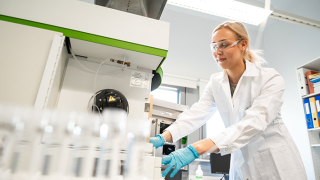University of Jyväskylä advances forest health and circular economy through ash utilization

significance for ash producers, forest owners, and other operators in the field.
Ash fertilization can significantly increase tree growth, improve forest health and reduce the need for peatland restoration. The national goal is to triple the amount of ash fertilization to 30,000 hectares per year.
- Ash fertilization offers a cost-effective solution that supports the circular economy, increases the economic and ecological value of forests and improves the carbon sink formation, says Senior Lecturer Rose Matilainen from the University of Jyväskylä.
Precise analysis of ash nutrients and metals with university-developed methods
The Heleä project "Solutions for a green transition by increasing the beneficial use of ash and ash fertilization" is coordinated by Jamk University of Applied Sciences. The University of Jyväskylä and the Finnish Forest Centre is also participating in the project.
- The University of Jyväskylä is responsible for researching the quality of ash. We analyze the nutrients and valuable metals contained in ash using methods developed and optimized by the university, says Postdoctoral Researcher Emilia Virtanen from the University of Jyväskylä.
The University of Jyväskylä analyzed a total of 26 ash samples from 20 plants in Central Finland. The samples contained bottom ash and fly ash.
- Our results showed that wood ash contains on average more nutrients for example phosphorus and potassium, and lower levels of harmful substances like arsenic, cadmium, nickel, copper, and chromium, explains Virtanen.
Most of the ash analyzed is suitable for use as forest fertilizer. The use of wood and peat ash may be limited by their high concentrations of harmful substances particularly arsenic and cadmium.
- We have developed a green method to address the problem. The ash is processed with organic acid, which allows arsenic and cadmium to be removed from the ash without significantly reducing the nutrient content of potassium and phosphorus. This is important for forests, says Virtanen.
The developed method ensures that the ash fulfils the legal requirements and can be used as forest fertilizer.
Industrial side streams and burning conditions affect ash
The concentrations of harmful substances in peat ash were lower for lead, zinc, and cadmium.
- However, the burning conditions must be taken into account in the results. For example, boiler materials can also affect the metal concentrations. When burning industrial side streams, nails or other metal parts may also affect the quality of the ash, Virtanen explains.
The Heleä project is co-funded by the European Union and is part of the Just Transition Fund (JTF) funding program. The project is also funded by Alva Oy, Finsilva Oy, Keuruun Energia Oy, Loimua Oy, Puulaakson Energia Oy, the City of Saarijärvi, Yara Suomi, MHY Karstula-Kyyjärvi and MHY Keski-Suomi.









